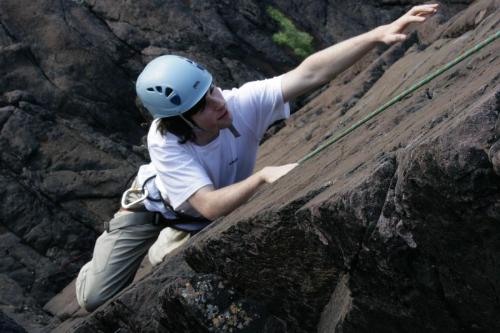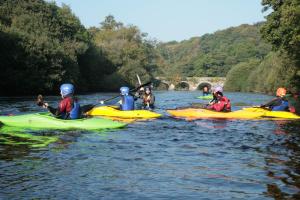In recent media coverage of the destruction of the Devil’s Ladder route on Corrán Tuathail, quotes from senior figures in Kerry Mountain Rescue merit clarification. “Long time member” Gerry Christie, is quoted in Saturday’s (May 3) Irish Examiner piece by Anne Lucey as saying; “My view is that people have to accept personal responsibility for their own safety on the mountain” It is a statement that would hardly find contradiction; a mantra of common sense issued throughout the ages – though as Gerry well knows, that too often falls on deaf ears. In relation to the topic being covered however, I am not sure what place such a statement has and presuming the quote is correct, perhaps he could clarify for us what’s meant therein. Mindful of the human activity that has undermined the Devil’s Ladder along with other routes on our hills, I wonder if perhaps he could clarify for us if the responsibility he believes in, extends to that for the erosion he and I, and others have contributed to. The lack of a cohesive management plan for our highest mountains which are privately owned by local landowners and now playing host to unprecedented numbers of walkers and climbers, is an issue that has exercised many of us for years. The dramatic collapse of the most famous route to our highest peak has been a particular concern and indeed the subject of numerous safety edicts from mountain rescue and others. Reading newspaper quotes this past few days, references are made to leading mountain rescue members expressing concern; “that the three most popular routes…..are in dire condition”. The facts indeed are correct, but the notion that leading mountain rescue members are concerned participants in dealing with all of this, is misleading. It may surprise people that in the five years since the local community (Beaufort) and others have attempted to provide the first, and only effort ever, at seriously mitigating against the erosion of the Devil’s Ladder, there has never been a single word of support from Kerry Mountain Rescue! As a former member, training officer and team co-ordinator with the association, I am well versed on it’s constitution that includes the promotion of safety on the hills. On numerous occasions the dangers inherent on the Devil’s Ladder have given rise to safety warnings from the organisation – but beyond this, there seems to a paralysis in addressing the situation. In the colourful history of mountain rescue in our region, many of those who have played an active role in this community service have often held diverse views in politics and other issues. It is notable however that over most of this time, no volunteers ever sought to hijack the association’s standing by promoting anything other than the core aims and objectives of the association; not the aims of Sinn Fein, An Taisce, Local Business, the Killarney Nature Conservation Group, the Pioneers, SPUC or the FCA. Such integrous adherence to this principle contributed in no small way to the respect the current generation of leadership inherited. In relation to the topic at hand, I would like to remind those who serve as volunteers in mountain rescue, that when speaking on issues of safety in the mountains (– the underpinning concern that gave rise to the setting up of the team in 1967) that they are under a moral obligation to do so without consideration to any personal feelings they may have on any other issues. On a personal level, Gerry Christie – like all other citizens, enjoys the right to hold whatever personal opinions he wishes in relation to the action plan on the Reeks that seeks address erosion control on the Devil’s Ladder with the construction of a rugged footpath. It is however, deeply unethical in my view for anyone passing through the history books of mountain rescue in Kerry to have any other influences other than safety, in any way contaminate a public opinion by the group. It would be helpful then if, finally, the association might see fit to unambiguously state where it stands, – in line with it’s aims and objectives, on the proposed works on the Devil’s Ladder; pointedly on the feasibility study carried out by the voluntary footpath group Mountain Meitheal, co-funded by the Mountaineering Council of Ireland and the Heritage Council of Ireland and adopted into the Beaufort Community Council’s Reeks Action Plan. In the absence of a management plan of any sort existing for our highest mountains, an local initiative has sought to address a handful of glaring issues in and around the McGillycuddy Reeks; among them engaging with Kerry County Council on assuming public ownership of a principle road leading to the mountains, the establishment of public car parks, looking at the issue of safe river crossings in the Hag’s Glen and seeking to implement the Devil’s Ladder Plan. In a community where mountain rescue has enjoyed powerful and widespread support over four decades, it beggars belief to many that clear unambiguous support for the safety aspects of this work has to be dragged from the present leadership. The enormous mess that is now the Devil’s Ladder is the result of huge numbers of walkers and climbers travelling over delicate terrain, the elements – and years of neglect and select responsibility by those of us who have contributed to it all. It is with deep regret now that at a time just a few years ago when a quote of less than € 100 k was negotiated to carry out work aimed preventing the scale of destruction now faced, and when voluntary effort secured funding for this work from statutory agencies, leading figures in Killarney Mountaineering Club and Kerry Mountain Rescue objected to the works that resulted in the loss of funding. The motives were widely perceived to be in bad taste arising out of personal prejudices and displaying a profound lack of vision and unwittingly or otherwise, undermined the authority and respect earned over 40 years by KMRT – and indeed left many in our community confused to say the least. Today as we continue to witness the most famous route to our highest mountain literally being washed away, many contributors not only seem oblivious to their role in all of this and in fact seek to undermine efforts at mitigation that reflect those employed throughout the world, leading members of mountain rescue might consider providing us with they feel should be done with the Ladder ? Constructive input from quarters content to mischievously play dog-in-the-manger on all of this up to now is long overdue and would mark a step forward in facing the difficult challenges ahead. For starters perhaps, they could point out a single situation – anywhere in the developed world, where a hill or mountain frequented by up to 1000 people per week is in a mess like ours, that has been left to fester and where a sacrificial track does not exist. Surely in the extensive travels of these mountaineers, they have crossed mountain streams in Glen Nevis on footbridges and trotted down tourist tracks off Snowdon or the likes where best practices on environmental and safety grounds have long ago led to responsible action being taken by communities and mountain enthusiasts. We await the definition of responsibility referred to by Mr Christie and hopefully, the active participation of all concerned in the near future.
Yours truly,
Con Moriarty ,
Gap of Dunloe, Beaufort, County Kerry









